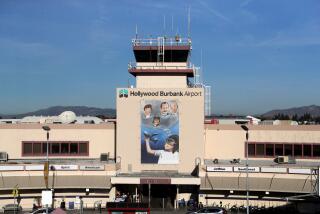Burbank Airport Board Told Legal Issues Peril Operations
The Burbank Airport is threatened by two legal problems that could soon shut it down, the president of the airport’s governing board warned Monday.
“This airport is in danger of effectively terminating its activities” because of a Federal Aviation Administration safety crackdown on outmoded facilities and also because of Monday’s U.S. Supreme Court ruling on airport noise lawsuits, Robert Garcin said.
The FAA warned the airport in a letter received Friday that the federal agency wants immediate action to correct long-standing objections regarding the airport’s layout. The agency wants the airport board to come up with a plan for a new, safer passenger terminal and to stop using one of its two runways for passenger plane takeoffs.
Garcin had just warned the other eight members of the Burbank-Glendale-Pasadena Airport Authority at their biweekly meeting Monday that the FAA’s action on its outmoded facilities “may close this airport” when word was received of the Supreme Court ruling. The high court upheld a state Supreme Court ruling that those who live near airports may sue the airports repeatedly for causing noise.
Unless the state Legislature protects Burbank from the effects of the ruling, Garcin said, “The airport will probably go broke and terminate its activities and sell the land for an industrial park.”
Currently about 243,000 passengers a month use the airport. Eight airlines make about 4,000 takeoffs and landings a month. The majority of flights are to and from points west of the Rockies.
The two legal problems complicated a vociferous debate between members of the authority, and between the authority and neighboring residents, over plans by United Air Lines to begin daily service in May between Burbank and Chicago using 197-passenger Boeing 767 wide-body jetliners.
No Wide-Body Jetliners
Except for new planes leaving the adjacent Lockheed-California Co. factory, there are no wide-body planes using the airport. The largest jetliner in commercial use at the airport carries 150 passengers.
Homeowners groups in the eastern San Fernando Valley, who have complained for years that the airport is continually expanding operations and generating more noise, attacked United’s plan, saying employing larger planes for longer flights would greatly change the character of the airport.
Some of those protesting the United plan accused Garcin of “scare tactics” Monday, implying that he was trying to whip up public support for United from airline users by threatening to close the airfield.
“I’m not trying to scare anybody, I’m trying to be realistic,” Garcin responded in an interview.
The effect of the Supreme Court ruling is to allow homeowners or others to continue to bring suits so long as the noise problem continues. The airport wanted to be considered a “permanent” nuisance, meaning it could have been sued only once by the same party.
‘Many Bites of Apple’
“If we were a permanent nuisance, there’d be only one bite of the apple. But as a continuing nuisance, there will be many bites of the apple until we’re down to nothing but the core,” Garcin said.
Unless airport advocates are finally successful in their attempts to change state law, he said, “there will be no airport here.”
Gov. George Deukmejian has twice vetoed bills to limit airport noise suits, but a third such measure is pending in the Legislature.
Airlines, which support the airport, will refuse to come up with high enough fees to pay for a constant flow of damage awards for medium-sized airports like Burbank, Garcin predicted. Economic necessity will force them to consolidate their operations at major airports like Los Angeles International, he said.
The same may be true, he said, of the money needed to meet the FAA demands.
Safety Question Raised
The FAA’s letter was sent in response to a request by the airport authority for comment on the safety aspect of United’s plans to use 767s. The safety questions had been raised by the protesters and by a minority of the authority’s members.
The FAA replied that not only is the agency “very concerned” about use of wide-body jetliners at Burbank, but a review of the airport’s standing raised more serious questions about other operations.
The airport, built in 1930, does not meet modern safety regulations, particularly the location of the passenger terminal, which is too close to the runways. FAA regulations require a 750-foot safety zone between a terminal and the center line of the closest runway. At some points, the present terminal is only 313 feet from the runway.
The airport has been operating for several years on waivers granted by the FAA on the condition that the authority build a new terminal, Garcin said.
A ruling by the Defense Department in December forced the airport authority to abandon plans, which had been under development for five years, to build a new terminal on land now owned by the Lockheed Corp. on the east side of the airport.
Close to ‘Skunk Works’
The federal government ruled that the site was too close to the “Skunk Works,” where Lockheed engineers work on highly secret military projects, so Lockheed pulled out of the deal.
The FAA’s letter--from the director of the Los Angeles office, H. C. McClure--said the waivers granted Burbank Airport since 1979 were “based on anticipated temporary or short-term use . . . However, there is now an increased level of air carrier operations, in addition to an extended delay on new terminal facilities.”
Garcin noted that the letter did not object solely to wide-bodied planes, but to any “additional service.”
The FAA also demanded that some “safety enhancements be implemented immediately,” including a ban on aircraft of commercial passenger size taking off from the airport’s east-west runway, which is 828 feet shorter than the north-south runway. “This letter can be interpreted as meaning Burbank Airport is now a one-runway airport,” Garcin said.
The loss is not great. A maximum of 5% of commercial flights take off on the east runway because the usual winds from the west do not favor its use.
The FAA also demanded that three parking lots be converted to aprons for airliners. The conversion would eliminate 1,457 auto parking spaces, despite a parking space shortage.
More to Read
Sign up for Essential California
The most important California stories and recommendations in your inbox every morning.
You may occasionally receive promotional content from the Los Angeles Times.










